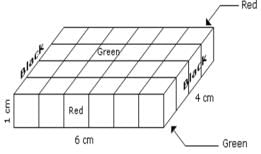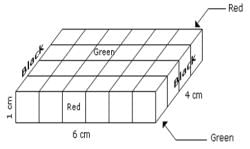Test: Cubes and Dice- 1 - CUET Commerce MCQ
10 Questions MCQ Test - Test: Cubes and Dice- 1
A cube is coloured orange on one face, pink on the opposite face, brown on one face and silver on a face adjacent to the brown face. The other two faces are left uncoloured. It is then cut into 125 smaller cubes of equal size. Now answer the following questions based on the above statements.
How many cubes have at least one face coloured pink?
A cube is coloured orange on one face, pink on the opposite face, brown on one face and silver on a face adjacent to the brown face. The other two faces are left uncoloured. It is then cut into 125 smaller cubes of equal size. Now answer the following questions based on the above statements.
How many cubes have at least two faces coloured?
A cube is coloured orange on one face, pink on the opposite face, brown on one face and silver on a face adjacent to the brown face. The other two faces are left uncoloured. It is then cut into 125 smaller cubes of equal size. Now answer the following questions based on the above statements.
How many cubes are coloured silver on one face, orange or pink on another face and have four uncoloured faces?
A cube is painted red on two adjacent surfaces and black on the surfaces opposite to red surfaces and green on the remaining faces. Now the cube is cut into sixty four smaller cubes of equal size.
How many smaller cubes will have no surface painted?
A cube is painted red on two adjacent surfaces and black on the surfaces opposite to red surfaces and green on the remaining faces. Now the cube is cut into sixty four smaller cubes of equal size.
How many smaller cubes have three surfaces painted?
A cube is painted red on two adjacent surfaces and black on the surfaces opposite to red surfaces and green on the remaining faces. Now the cube is cut into sixty four smaller cubes of equal size.
How many smaller cubes have at least one surface painted with green colour?
A cube of 4 cm has been painted on its surfaces in such a way that two opposite surfaces have been painted blue and two adjacent surfaces have been painted red. Two remaining surfaces are unpainted. Now the cube is cut into smaller cubes of side 1 cm each.
How many cubes will have at least red colour on its surfaces?
A cube of 4 cm has been painted on its surfaces in such a way that two opposite surfaces have been painted blue and two adjacent surfaces have been painted red. Two remaining surfaces are unpainted. Now the cube is cut into smaller cubes of side 1 cm each.
How many cubes will have only two surfaces painted with red and blue colour respectively?
A cuboid shaped wooden block has 6 cm length, 4 cm breadth and 1 cm height. Two faces measuring 4 cm × 1 cm are coloured in black. Two faces measuring 6 cm × 1 cm are coloured in red. Two faces measuring 6 cm × 4 cm are coloured in green. The block is divided into 6 equal cubes of side 1 cm (from 6 cm side), 4 equal cubes of side 1 cm (from 4 cm side).
How many cubes having red, green and black colours on at least one side of the cube will be formed ?
A cuboid shaped wooden block has 6 cm length, 4 cm breadth and 1 cm height. Two faces measuring 4 cm × 1 cm are coloured in black. Two faces measuring 6 cm × 1 cm are coloured in red. Two faces measuring 6 cm × 4 cm are coloured in green. The block is divided into 6 equal cubes of side 1 cm (from 6 cm side), 4 equal cubes of side 1 cm (from 4 cm side).
How many cubes will have 4 coloured sides and two non-coloured sides?
















